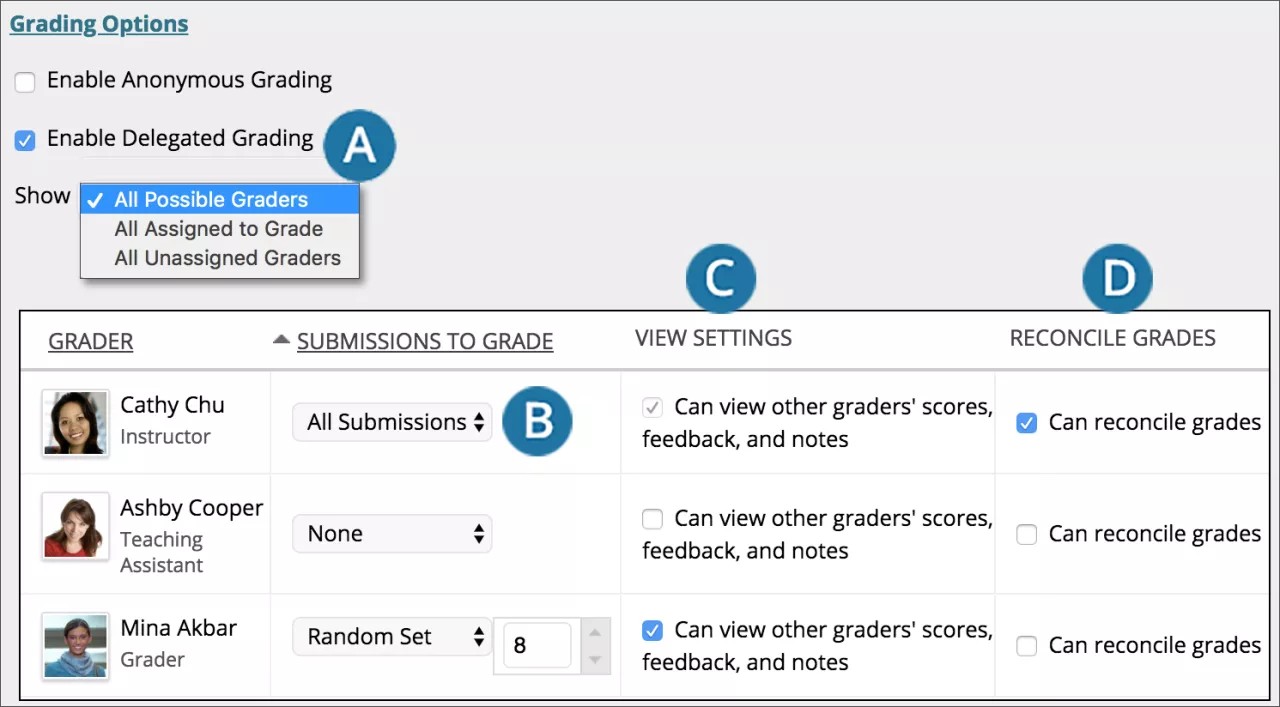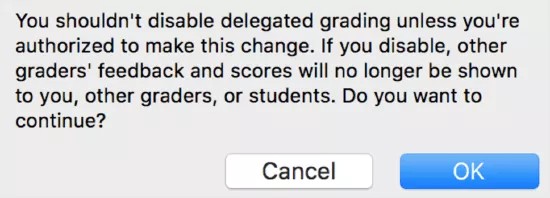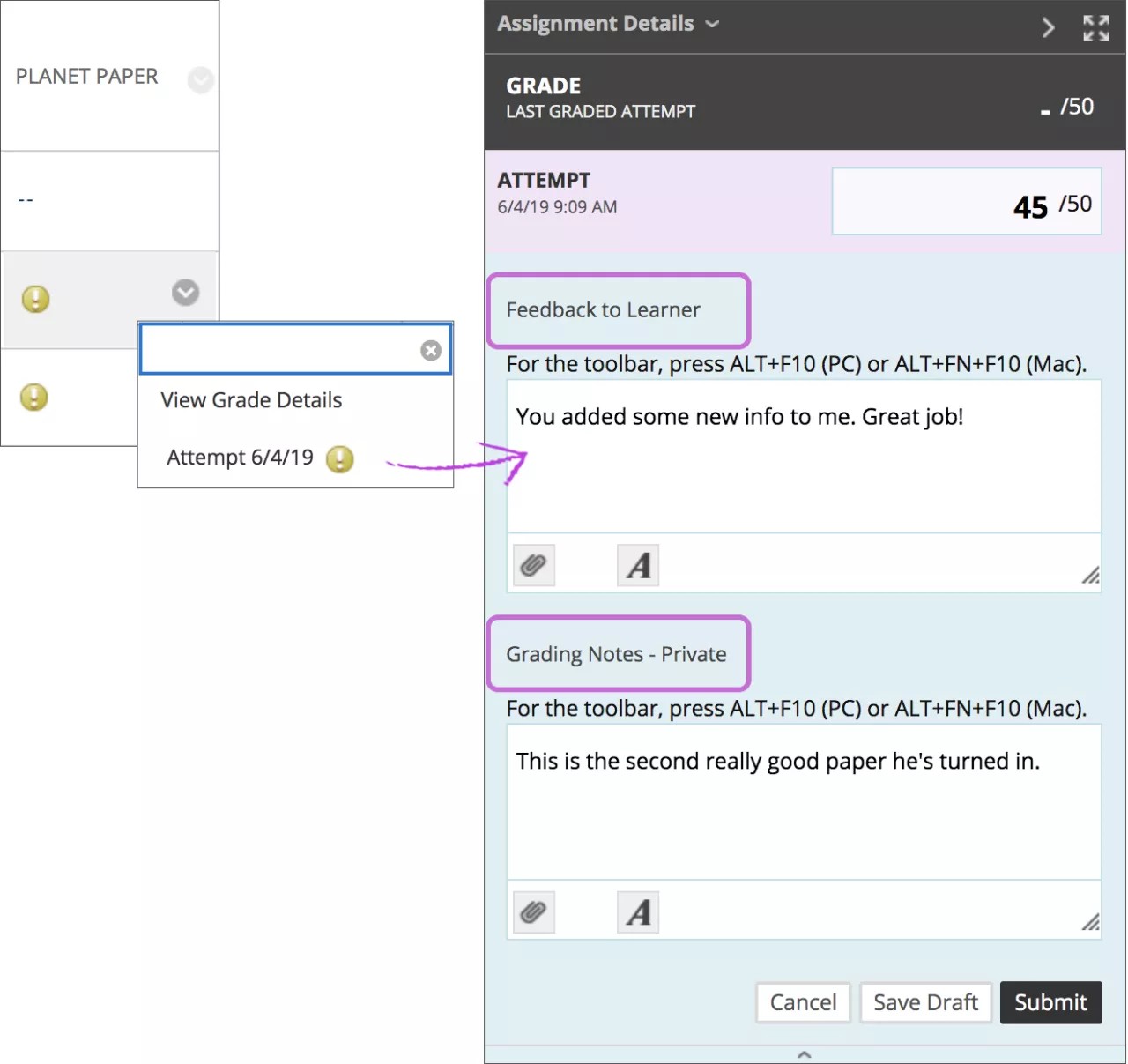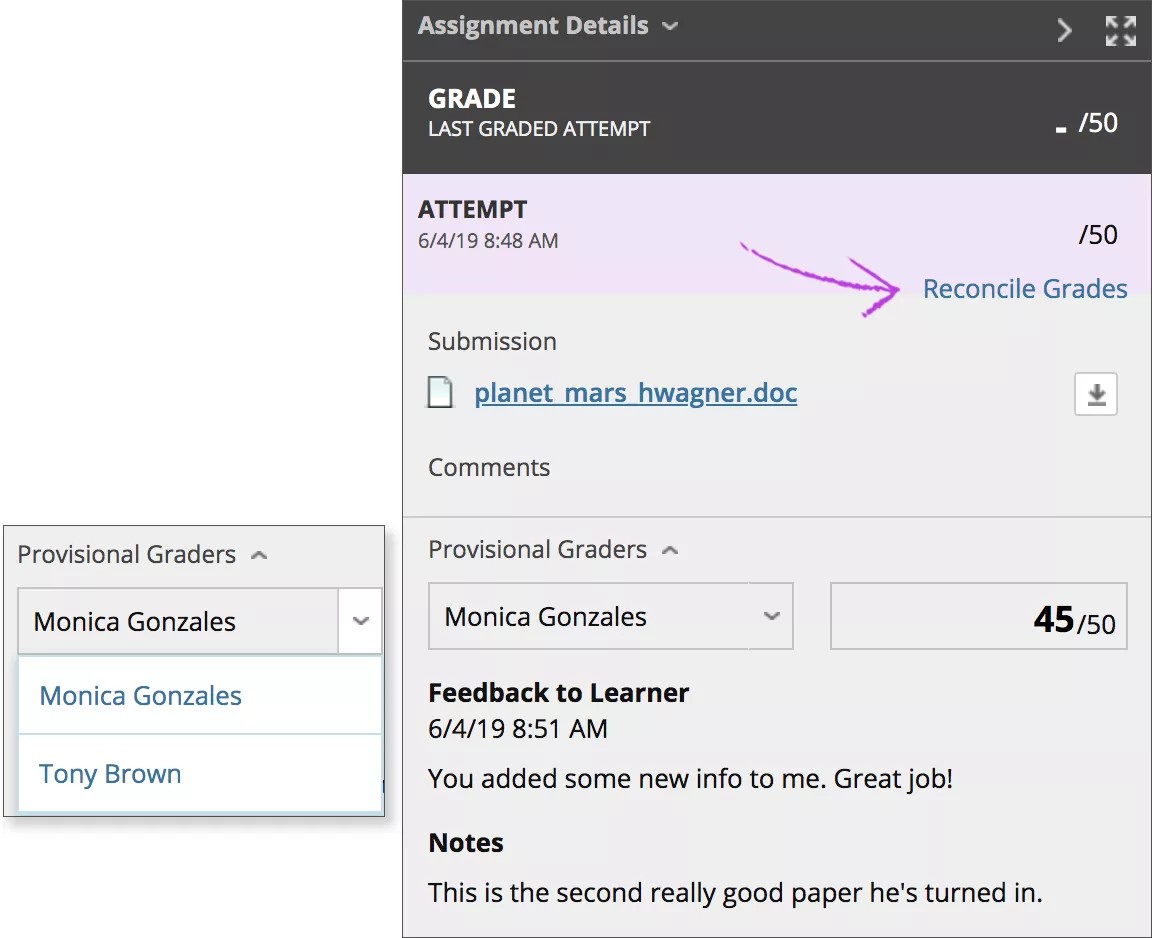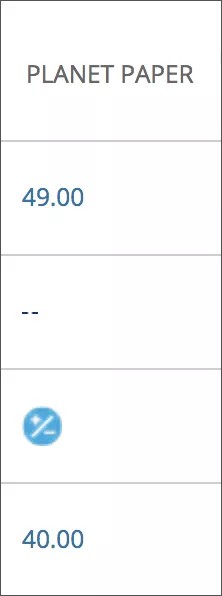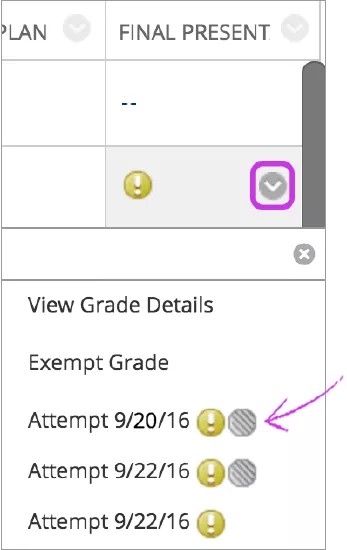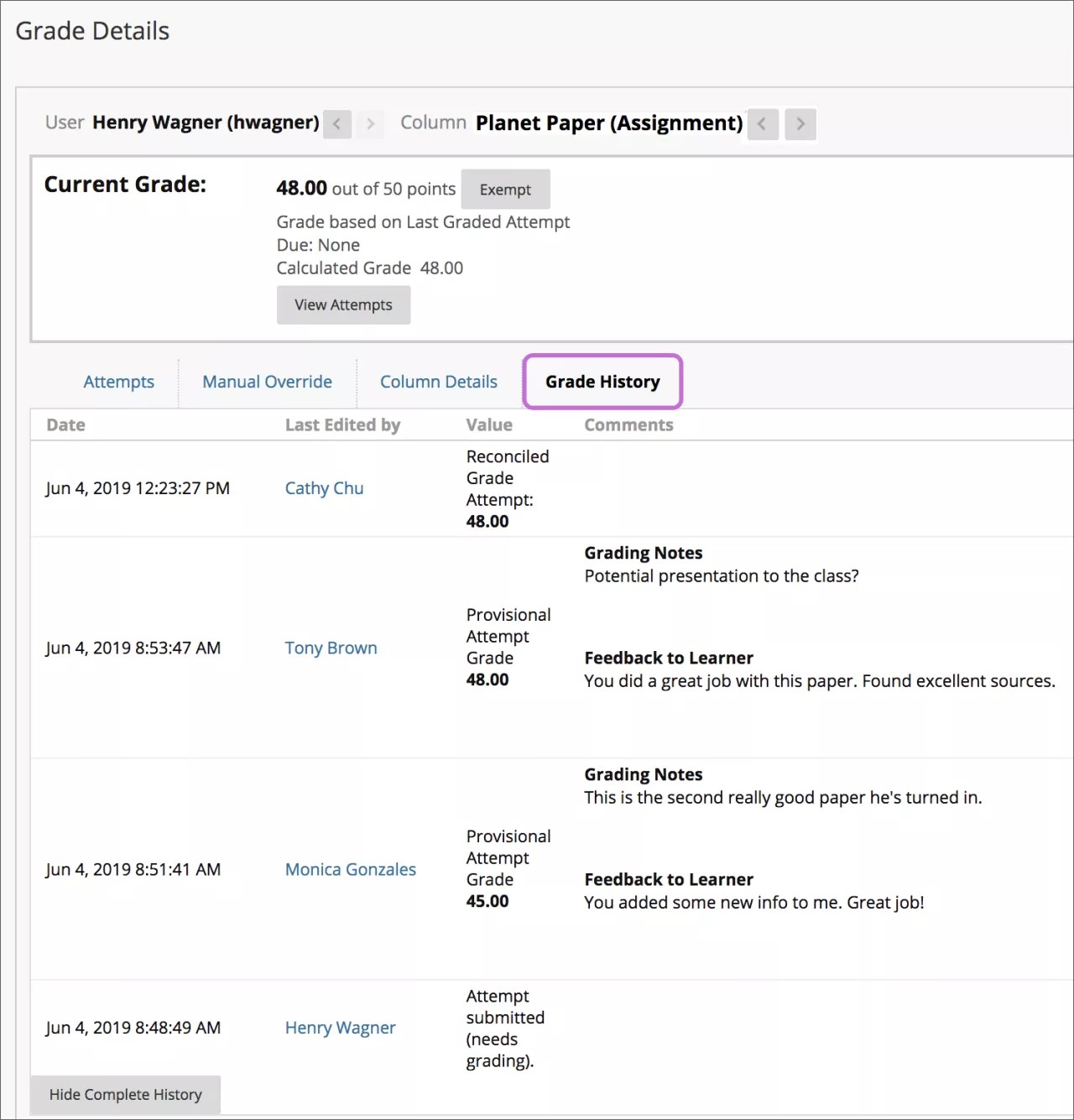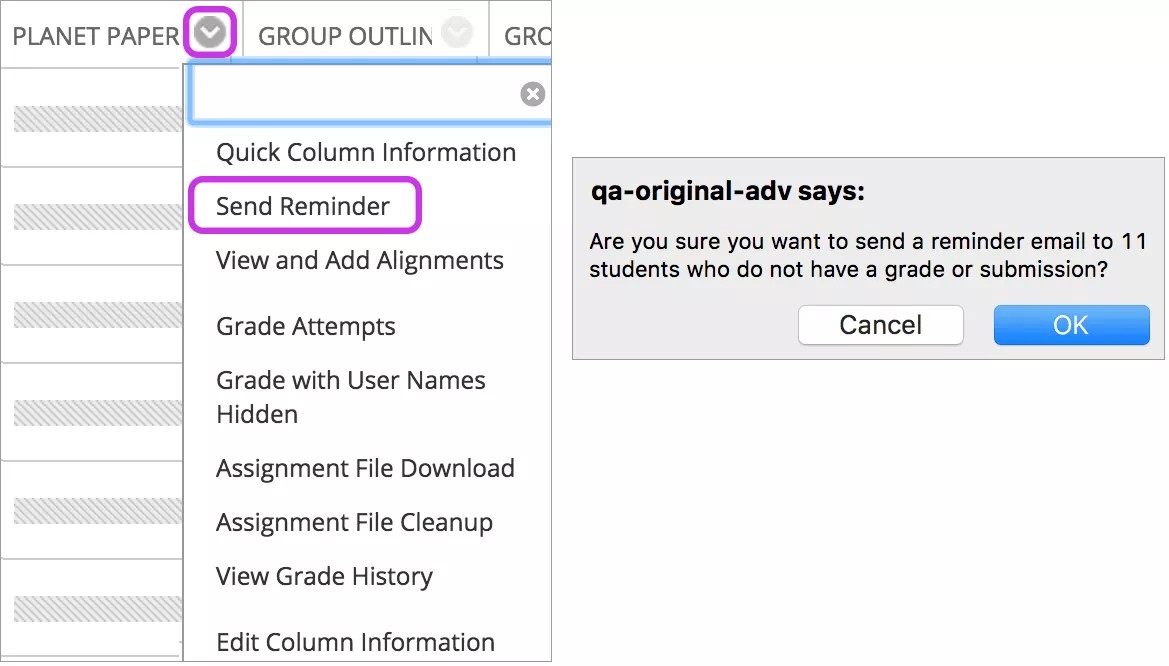This information applies only to the Original Course View. Your institution controls which tools are available.
You can assign specific users in your course to grade particular sets of student assignment submissions. Roles with default grading privileges include instructor, teaching assistant, and grader. As part of the delegation grading workflow, you can also assign the ability to reconcile grades to graders.
The users who help you grade are called delegated graders and they provide provisional grades. Delegated graders follow the same grading steps you do. However, the group of assignment attempts they see is based on the options you choose. After all delegated graders provide grades and feedback, one or more final graders review the grading to determine a final grade or reconcile it.
Why use delegated grading?
Grading and feedback from more than one grader promote reliability, improve consistency, and remove bias. You can assign blind graders, who can't see each others' ratings, to the same set of submissions. You'll have more than one critique of the same sample of work. You can use all of the blind graders' ratings to determine the assignment's final grade.
Whenever fairness and impartiality in grading are an institutional requirement or a concern, use blind graders to control bias among graders as much as possible.
For large classes, you can divide up the grading tasks among teaching assistants and other graders. For a merged course, you can assign each grader a class section.
More on delegated grading examples
Should I allow graders to collaborate?
You can allow graders to view each other's grades, annotations, and feedback. When graders know your students well, their growth and past performance should influence grading. Collaborative grading is also appropriate for small classes where students are encouraged to discuss the assignment at all stages of creation. The goal is collaboration at all levels, including grading.
Delegated grading workflow
Use these steps to enable and grade with delegated grading:
- Enable delegated grading
- View grading alerts
- Access and grade submissions
- View reconcile grade alerts
- Reconcile grades
At the time of assignment creation, you can also enable anonymous grading so graders don't see students' identities. You can also enable the SafeAssign option to prevent plagiarism.
Video: Delegated Grading
Watch a video about delegated grading
The following narrated video provides a visual and auditory representation of some of the information included on this page. For a detailed description of what is portrayed in the video, open the video on YouTube, navigate to More actions, and select Open transcript.
Video: Delegated grading explains how to set up delegated grading when you create an assignment.
1. Enable delegated grading
On the Create Assignment page, choose the graders and final graders to help with grading tasks. If you're using groups, groups must be set to Available to students or the assignments won't be available for grading.
- In the Grading Options section, after you select the check box for Enable Delegated Grading, you can view a list of potential graders and final graders. Use the Show menu to filter the list.
- Use the menu next to each grader's name to assign submissions to grade:
- All Submissions
- Random Set: Grade a random set of the selected number of students. If you assign multiple graders to grade a random set, students are distributed evenly before any student is included in multiple random sets.
- Groups: Grade all students who are members of the selected course groups.
- None
- All instructors in a course can see what other graders are assigned. If you want other roles to also view scores, feedback, annotations, and private notes added by others, select the check box in the View Settings column. Students do not see the private notes anyone adds.
- In the Reconcile Grades column, choose who can determine the final grade and feedback for each student. All instructors can reconcile grades. Instructors can allow teaching assistants and graders to reconcile grades. Users who reconcile grades are also called final graders.
To help with the accuracy and consistency of grading, ask all delegated graders to use a rubric when they provide grades.
Disable delegated grading
After you create an assignment with delegated grading enabled, you or other privileged users can disable it.
Use caution before you disable this setting. In older versions of Blackboard Learn, when you clear the check box, you have no chance to change your mind.
When you clear the check box for delegated grading, a warning appears. If you choose to continue, other graders' feedback and scores will no longer be shown to you, other graders, or students. If you want to keep the delegated grading setting, select Cancel.
You won't see this warning if your institution uses an older version of Blackboard Learn.
2. View grading alerts
Example: You select two delegated graders and assign each grader a random set of submissions. Each grader sees only the attempt submissions that are part of their individual random sets.
Users are notified when delegated assignment submissions are ready to grade. Alerts appear in these areas:
- Needs Grading page
- Grade Center grid: The Needs Grading icon appears only in the cells that the grader is assigned to grade
- Notification modules
- My Blackboard > Updates page
- Individual email notifications, if enabled
- SMS, voice, and daily digest email notifications, if enabled
3. Access and grade submissions
You can access assignment submissions that you're assigned to grade in the Grade Center and on the Needs Grading page. If anonymous grading is also enabled, student names are hidden. Graders can view how many gradable items are in their queues.
Both access options open the Grade Assignment page where you view submissions, annotate files, and grade as you normally do.
In the Feedback to Learner box, select the editor icon represented by the letter A to open the pop-up editor window.
Each instructor and final grader has the ability to view what other graders provided for scores, feedback, annotations, and private notes. Graders and teaching assistants who aren't final graders don't see this information unless you allowed it when you created the assignment. If allowed, a grader can view the file annotations made by another grader and add more.
The final grader sees a Reconcile Grades link when grades are ready to reconcile.
Students do not see the private notes anyone adds. Students see the comments provided in the Feedback to Learner box and the file annotations. You can hide all the graders' feedback when you determine the final grade.
After you provide a grade, the Needs Reconciliation icon appears in the Grade Center cell. No score appears until the final grader reconciles the grade.
Video: Grader Workflow for Delegated Grading
Watch a video about the grader workflow
The following narrated video provides a visual and auditory representation of some of the information included on this page. For a detailed description of what is portrayed in the video, open the video on YouTube, navigate to More actions, and select Open transcript.
Video: Grader workflow explains the grader's workflow for delegated grading in an Original Course.
Multiple attempts
When you allow multiple attempts, you may not need to grade all of them. In the grade cell's menu, each attempt appears with one or two icons. If you chose to use the first or last attempt for the grade, the attempt you need to grade appears with only one icon—the Needs Grading icon. If you have a large class and grading workload, you'll know which attempts need your attention.
The other attempts in the grade cell's menu appear with the Does not contribute to user's grade icon and the Needs Grading icon.
You won't see the "Does not contribute to user's grade" icon if your institution uses an older version of Blackboard Learn.
You can also use the Filter function to control which attempts appear in each grade cell's menu. The default view shows each attempt made. Open the Filter field and clear the check box for Show attempts that don't contribute to user's grade. Then, you'll see only the attempt you need to grade in each grade cell's menu.
Important: If you allow four attempts and choose to use the last attempt for the grade, only the Needs Grading icon appears with the last submitted attempt. So, if a student has made three attempts, the third attempt appears with only one icon—the Needs Grading icon. If you grade that attempt, the student can still make another attempt. The next attempt will appear with only the Needs Grading icon because it's the fourth and last attempt.
For some gradable items such as assignments, you can also select Grade Attempts in a grade column's menu and start grading. Attempts that aren't part of a student's grade calculation appear with the Does not contribute to user's grade icon. You can navigate to the attempt that appears with only the Needs Grading icon.
You can also filter your grading workload for multiple attempts on the Needs Grading page and view attempts on the Grade Details page. If you enabled anonymous grading for an assignment, multiple attempts are managed in the same ways. To protect anonymity, students' names and attempt statuses are hidden.
More on multiple attempts and anonymous grading
4. View reconcile grade alerts
After delegated graders begin providing grades, the final graders receive notifications that grades need reconciling. These alerts appear in these areas:
- Needs Grading page: Needs Reconciliation appears at the top of the table
- My Blackboard > Updates page
- Grade Center grid: Needs Reconciliation icon appears in the cells
- Notification modules
- Individual email notifications, if enabled
- SMS, voice, and daily digest email notifications, if enabled
You can also access the Reconcile Grades page from a student's cell menu > View Grade Details page.
5. Reconcile grades
The final grader reviews all grades and feedback made by graders and determines the final grades. Regardless of how many student attempts an instructor role is assigned or even if none are assigned, all instructors can reconcile grades.
Your administrator can assign the reconcile privilege to other roles as needed.
You can access the Reconcile Grades page from these areas:
- Needs Grading page > Needs Reconciliation tab at the top of the page
- Column header menu in the Grade Center
- A student's Grade Assignment page
The final grader selects Reconcile Grades from one of the access points, such as the student's Grade Assignment page. Other grader roles who have graded attempts see the Needs Reconciliation icon in the Grade Center, but don't have access to the Reconcile Grades page.
On the Reconcile Grades page, the final grader can view all the grades and feedback that all graders assigned and see who has grading to perform. For large classes, filter the list by status and grader. On this page, you accept the grades set by another -OR- review grades assigned by multiple graders and set the final grades.
- Show Grader Progress: View the progress of all graders, what the grader assigned for the average grade for the assignment, and the number of attempts.
- Show Detail View icon: View existing grades, feedback, and optional rubric. You can hide all the graders' feedback, add new feedback, and determine the final grade. Learn more in the next section.
- Add Grader icon: Open a window to add one or more graders for this student.
- Final Grade column: Use a student's menu to assign the final grade. Or, use the Final Grade menu in the column header to reconcile grades in bulk for highest, lowest, or the average of the graders' scores.
The final grader can choose not to reconcile the grade and may return it to the Needs Grading status. Delegated graders can grade attempts again after the attempt is in Needs Grading.
About the Show Detail View window
Point to a student's name to access the Show Detail View icon and open a window with specific details about only that student's evaluations. When you reconcile from a specific student's window, the reconciliation is just for that student.
Clear the check box for Show Graders' Feedback and Rubrics (if applicable) to student if you want to hide the graders' evaluations. Select Add Feedback to add your comments for the student.
If you add feedback as the final grader, your feedback is the only feedback you'll see on the Grade History tab. On their Review Submission pages, students see the graders' feedback if allowed, along with yours as the final grader.
Reminder: Comments in the Grading Notes box aren't shown to students.
Reconciled grades appear
After you reconcile grades, the Needs Reconciliation icons are replaced with the scores you assigned. You can view the scores and feedback each grader assigned on the student's Grade Details page in the Grade History tab.
Students see their reconciled scores and any feedback from the final grader in My Grades. Students can also select the name of the assignment in the content area to access the Review Submission History page. Students can view the score assigned by the final grader and view the feedback from all graders, if allowed.
Reminder: When you reconcile grades, final graders have the option to not show delegated graders' feedback to students and provide their own.
Video: Final Grader Workflow for Delegated Grading
Watch a video about the final grader workflow
The following narrated video provides a visual and auditory representation of some of the information included on this page. For a detailed description of what is portrayed in the video, open the video on YouTube, navigate to More actions, and select Open transcript.
Video: Final grader workflow explains the final grader's workflow for delegated grading in an Original Course.
Send reminders about missing coursework
You can send email reminders from Grade Center columns to students and members of groups who have missing coursework. Students receive a system-generated email that lists the course, coursework, and the due date if you assigned one. You receive a success message at the top of the screen when the email is sent.
You can also send reminders for assignments with anonymous or delegated grading enabled. To protect anonymity, students' names and attempt statuses are hidden.
You won't see this menu option if your institution uses an older version of Blackboard Learn.
Delegated grading and content exchange
Delegated graders and settings are carried over to a new course when you use these content exchange functions:
- Copy Course with Users (Exact Copy)
- Copy Course Materials into a New Course and select the check box for Include Enrollments in the Copy
- Archive/restore—users and settings are part of an archived course
Users with course roles that are designated to be able to grade submissions can be assigned for grading. Others are excluded.
More on course roles and course role permissions
Without enrollments
When you copy a course without enrollments into a new course, the delegated setting is brought over as enabled for all existing delegated grading assignments. The instructor who copies the course is set to grade all submissions and reconcile grades.
When you copy or import a course without enrollments into an existing course, the delegated setting is brought over as enabled for all existing delegated grading assignments. All current users who can reconcile are also set to grade all submissions.

